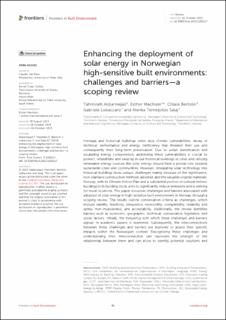| dc.description.abstract | Heritage and historical buildings often face climate vulnerabilities, decay of
technical performance and energy inefficiency that threaten their use and
consequently their long-term preservation. Due to urban densification and
escalating energy consumption, addressing these vulnerabilities is crucial to
protect, rehabilitate and keeping in use historical buildings in cities and utilizing
renewable energy sources like solar energy should have a pivotal role towards
sustainable cities and communities. However, integrating solar technology into
historical buildings faces unique challenges mainly because of the significance,
non-standard construction methods adopted, and the valuable original materials.
Norway, with its Climate Action Plan and a substantial portion of cultural historic
buildings in its building stock, aims to significantly reduce emissions and is seeking
for novel solutions. This paper discusses challenges and barriers associated with
adoption of solar energy in high-sensitive built environment in Norway, through a
scoping review. The results outline conservation criteria as challenges, which
include viability, feasibility, integration, reversibility, compatibility, reliability and
safety, non-invasiveness, and acceptability. Additionally, the review identifies
barriers such as economic, geographic, technical, conservative, legislative, and
social factors. Initially, the frequency with which these challenges and barriers
appear in academic papers is examined. Subsequently, the interconnections
between these challenges and barriers are explored to assess their specific
impacts within the Norwegian context. Recognizing these challenges and
understanding their interconnection can represent the strength of the
relationship between them and can allow to identify potential solutions and strategies to support stakeholders, experts, or public authorities for successfully
implementation and integration of solar energy systems in high-sensitive built
environments in the future. | en_US |

